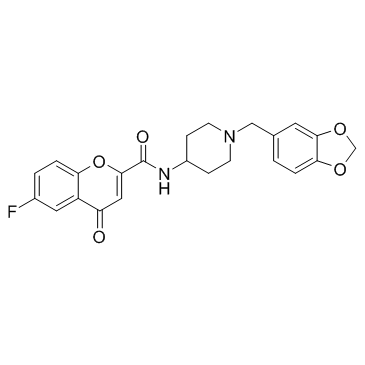MCHr1 antagonist 2 |
| Catalog No.GC31505 |
MCHR1 antagonist 2 is an antagonist of melanin concentrating hormone receptor 1, with an IC50 of 65 nM; MCHR1 antagonist 2 also inhibits hERG, with an IC50 of 4.0 nM in IMR-32 cells.
Products are for research use only. Not for human use. We do not sell to patients.

Cas No.: 863115-70-2
Sample solution is provided at 25 µL, 10mM.
MCHr1 antagonist 2 is an antagonist of melanin concentrating hormone receptor 1, with an IC50 of 65 nM; MCHr1 antagonist 2 also inhibits hERG, with an IC50 of 4.0 nM in IMR-32 cells.
MCHr1 antagonist 2 (Compound 30) is an antagonist of melanin concentrating hormone receptor 1, with an IC50 of 65 nM. MCHr1 antagonist 2 has inhibitory effects on Ca2+ flux, and hERG, with IC50s of 196 ± 30 nM and 4.0 ± 0.8 nM, respectively, in IMR-32 cells[1].
[1]. Lynch JK, et al. Optimization of chromone-2-carboxamide melanin concentrating hormone receptor 1 antagonists: assessment of potency, efficacy, and cardiovascular safety. J Med Chem. 2006 Nov 2;49(22):6569-84.
Average Rating: 5 (Based on Reviews and 39 reference(s) in Google Scholar.)
GLPBIO products are for RESEARCH USE ONLY. Please make sure your review or question is research based.
Required fields are marked with *




















